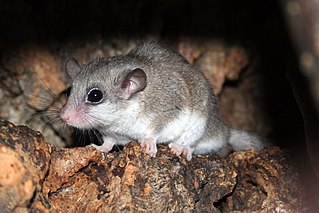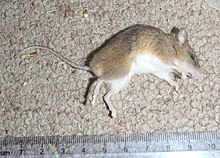
A dormouse is a rodent of the family Gliridae. Dormice are nocturnal animals found in Africa, Asia, and Europe. They are named for their long, dormant hibernation period of six months or longer.

The Nesomyidae are a family of African rodents in the large and complex superfamily Muroidea. It includes several subfamilies, all of which are native to either continental Africa or to Madagascar. Included in this family are Malagasy rodents, climbing mice, African rock mice, swamp mice, pouched rats, and the white-tailed rat.

Dendromurinae is a subfamily of rodents in the family Nesomyidae and superfamily Muroidea. The dendromurines are currently restricted to Africa, as is the case for all extant members of the family Nesomyidae. The authorship of the subfamily has been attributed to both Alston, 1876, and (incorrectly) to G. M. Allen, 1939.

Delany's mouse or Delany's swamp mouse is a species of rodent in the family Nesomyidae. It is the only species in the genus Delanymys and the only extant member of subfamily Delanymyinae, which also contains the fossil genus Stenodontomys. It was previously placed in subfamily Petromyscinae, but it is apparently not closely related to Petromyscus. It is found in Democratic Republic of the Congo, Rwanda, and Uganda. Its natural habitats are subtropical or tropical high-altitude shrubland and swamps. It is threatened by habitat loss.
The northwestern fat mouse is a species of rodent in the family Nesomyidae. It is native to tropical West Africa where it occurs on grassland and crop land.
The dainty fat mouse is a species of rodent in the family Nesomyidae. It is found in Benin, Burkina Faso, Mali, Niger, Nigeria, and Senegal. Its natural habitat is subtropical or tropical dry shrubland.
The Jackson's fat mouse is a species of rodent in the family Nesomyidae. It is found in Ghana, Nigeria and possibly Benin. Its natural habitats are arable land.

The Krebs's fat mouse is a species of rodent in the family Nesomyidae. It is found in Angola, Botswana, Lesotho, Namibia, South Africa, and Zambia. Its natural habitats are Mediterranean-type shrubby vegetation and subtropical or tropical high-altitude grassland. Its name honours Georg Ludwig Engelhard Krebs (1792–1844), a German natural history collector in South Africa.
The tiny fat mouse is a species of rodent in the family Nesomyidae. It is found in Angola, Botswana, Ethiopia, Kenya, Mozambique, Namibia, South Sudan, Tanzania, Uganda, Zambia, and Zimbabwe. Its natural habitats are subtropical or tropical dry shrubland and subtropical or tropical dry lowland grassland.
The fat mouse is a species of rodent in the family Nesomyidae. It is found in Angola, Botswana, Cameroon, Democratic Republic of the Congo, Malawi, Mozambique, Namibia, South Africa, Tanzania, Zambia, and Zimbabwe. Its natural habitats are dry savanna and subtropical or tropical dry lowland grassland.
Pousargues's African fat mouse is an extant species of rodent indigenous to the Central African Republic, Cameroon, and the Democratic Republic of the Congo. Given the distribution of the species throughout central Africa, the probability of a 'large population', and the security of its habitat, the International Union for Conservation of Nature (IUCN) recognises S. opimus as stable. Although the species is comparable in size to S. bocagei, the former exhibits an extra, abdominal pair of teats. In comparison to S. pratensis, S. opimus is significantly larger, while further comparison is necessary with S. jacksoni.
Bocage's African fat mouse is an extant species of rodent indigenous to Angola, the Republic of the Congo, and the Democratic Republic of the Congo (DRC). Given the distribution of the species across the Angolan Plateau and south-west of the DRC throughout central Africa, the probability of a 'large population', and the security of its habitat, the International Union for Conservation of Nature (IUCN) recognises S. bocagei as stable. Whereas taxonomies early in the twentieth century posit S. bocagei as a species, more contemporary records from 1977 onwards identify it as indistinguishable from S. pratensis. In 1998, however, Crawford-Cabral proposed that the additional pair of teats in S. bocagei required separation from S. pratensis. Subsequent to Crawford-Cabral's publication, Wilson and Reader maintain in Mammal Species of the World that the size of these species also requires differentiation, where S. bocagei is significantly larger than S. pratensis and is unique or otherwise corresponds to S. opimus.





